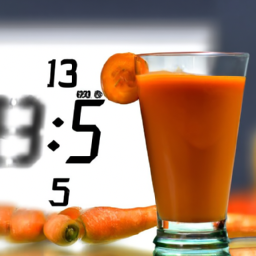Aloe vera juice is a refreshing oasis in a desert of unhealthy beverage choices. This drink not only quenches your thirst but also provides numerous health benefits. Yet, the conflicting opinions on the proper amount of aloe vera juice to drink can make it difficult to figure out the ideal dosage for you.
In this article, I’ll be exploring the nutritional content of aloe vera juice, the health benefits it offers, the recommended intake, as well as precautions and side effects to keep in mind. By the end of this article, you’ll have a clear idea of how much aloe vera juice you should be drinking to reap the benefits of this rejuvenating drink.
Key Takeaways
- Recommended intake of aloe vera juice is one to two ounces per day
- Excessive consumption of aloe vera juice can have adverse effects on health
- High-quality aloe vera juice should be organic and non-GMO with a high percentage of aloe vera gel
- Aloe vera supplements are also available in different forms
Nutritional Content of Aloe Vera Juice
If you’re wondering about the nutritional goodies packed in aloe vera juice, you’ll be happy to know that it’s chock-full of vitamins, minerals, and antioxidants. Aloe vera juice contains high levels of vitamins A, C, and E, which are important for maintaining healthy skin, hair, and nails. It also has high levels of minerals like calcium, magnesium, and potassium, which are essential for maintaining healthy bones and muscle function.
Furthermore, aloe vera juice has a variety of antioxidants, such as polyphenols and flavonoids, which help to protect the body from cell damage caused by free radicals. Aside from its nutritional content, aloe vera juice is also known for its health benefits and medicinal properties. Some studies have shown that aloe vera juice can help to lower cholesterol levels, reduce inflammation, and improve digestion.
It has also been used to treat skin conditions like psoriasis and acne, and may even have anti-cancer properties. With all of these potential health benefits, it’s no wonder that aloe vera juice has become a popular health trend in recent years. In the next section, we’ll delve deeper into the health benefits of aloe vera juice.
Health Benefits of Aloe Vera Juice
I’ve found that consuming aloe vera juice has numerous health benefits.
Firstly, it can improve digestive health by reducing inflammation, aiding in nutrient absorption, and easing symptoms of gastrointestinal disorders.
Secondly, aloe vera juice can promote skin health by reducing acne, hydrating the skin, and improving its elasticity.
Thirdly, it can also boost the immune system and act as a weight loss aid due to its anti-inflammatory properties and ability to regulate blood sugar levels.
Digestive Health
Drinking a moderate amount of aloe vera juice can help improve digestive health. Aloe vera contains compounds that are known to have a soothing effect on the digestive system, making it a popular remedy for digestive issues such as constipation, acid reflux, and irritable bowel syndrome. In addition to its soothing properties, aloe vera juice also contains enzymes that help break down food, which can improve digestion and nutrient absorption.
To further improve digestive health, it’s important to incorporate probiotic supplements and fiber-rich foods into your diet. Probiotics are beneficial bacteria that live in the gut and help maintain a healthy balance of microorganisms. Fiber-rich foods, on the other hand, help promote regular bowel movements and prevent constipation. By combining these dietary changes with a moderate amount of aloe vera juice, you can improve your digestive health and overall well-being.
In the next section, we will explore how aloe vera juice can benefit skin health.
Skin Health
To improve your skin health, consider incorporating aloe vera into your skincare routine with the adage "an ounce of prevention is worth a pound of cure."Aloe vera has been proven to have anti-inflammatory properties, making it an excellent choice for those with sensitive or acne-prone skin.
Topical applications of aloe vera can help soothe dry, irritated skin, reduce redness, and promote healing of minor cuts and burns. In addition to its benefits as a topical treatment, aloe vera can also be used in DIY skincare recipes. Mixing aloe vera gel with other natural ingredients such as honey, green tea, or coconut oil can create a nourishing face mask or moisturizer.
Incorporating aloe vera into your skincare routine can help give your skin a healthy, glowing appearance. With its many benefits, aloe vera is a versatile ingredient that can benefit your skin in a variety of ways.
Transitioning to the subsequent section about the "immune system boost,"it’s important to note that a healthy immune system is also key to maintaining good skin health.
Immune System Boost
Boosting your immune system is crucial for overall health and vitality, and there are many natural ways to achieve this. One of the most popular natural remedies for boosting immunity is aloe vera juice.
Aloe vera contains a variety of vitamins, minerals, and antioxidants that can help increase resistance to viruses and bacteria. It also has anti-inflammatory properties that can reduce inflammation and support a healthy immune response.
Studies have shown that regularly drinking aloe vera juice can help boost immunity, improve digestion, and even promote healthy skin. To reap the benefits of aloe vera juice, it’s recommended to drink 2-4 ounces daily. However, it’s important to note that aloe vera juice can have a laxative effect, so it’s best to start with a small amount and gradually increase the dosage.
With regular consumption, aloe vera juice can be a powerful ally in boosting immunity and promoting overall health.
Moving on to the next section, let’s explore how aloe vera juice can also be a helpful aid for weight loss.
Weight Loss Aid
You must be thrilled to hear that a plant you’ve always associated with sunburn relief can actually help you shed some extra pounds. Aloe vera juice has gained popularity as a weight loss aid due to its ability to boost metabolism and suppress appetite.
Here are some healthy alternatives to incorporate into your diet along with aloe vera juice:
-
Whole grains: Incorporating whole grains into your diet can help you feel fuller for longer periods of time, reducing the urge to snack on unhealthy foods.
-
Lean protein: Including lean protein sources like chicken, fish, and tofu in your meals can also help you feel full for longer periods of time.
-
Exercise routines: Aloe vera juice can help you lose weight, but incorporating exercise routines can help you maintain your weight loss in the long run.
It’s important to note that while aloe vera juice can aid in weight loss, it should not be relied on as the sole method of weight loss. Consult with a healthcare professional before making any significant changes to your diet and exercise routine.
Recommended Intake of Aloe Vera Juice
When it comes to the recommended intake of aloe vera juice, there are several factors to consider. These include age, weight, and overall health status.
As a general guideline, it’s recommended to drink one to two ounces of aloe vera juice per day for maximum health benefits. However, some individuals may be able to tolerate up to eight ounces per day without adverse effects.
Factors Affecting Recommended Intake
One important factor in determining how much aloe vera juice to drink is your individual health and medical history. Here are some key factors that can impact the recommended intake of aloe vera juice:
-
Dietary restrictions: If you have certain dietary restrictions, such as a low-carb or low-sugar diet, you may need to adjust your intake of aloe vera juice accordingly. Some aloe vera juices contain added sugars or other ingredients that may not be compatible with your diet.
-
Medical conditions: If you have certain medical conditions, such as diabetes or digestive problems, you may need to be more cautious with your intake of aloe vera juice. Aloe vera juice can interact with certain medications and may exacerbate certain health conditions.
-
Age: Young children and elderly individuals may need to adjust their intake of aloe vera juice, as their bodies may not be able to handle large amounts of the juice.
-
Overall health: Your overall health and wellness can also impact the recommended intake of aloe vera juice. If you’re generally healthy and have no underlying health conditions, you may be able to consume more aloe vera juice without any adverse effects.
It’s generally recommended to consume one to two ounces of aloe vera juice per day. However, it’s important to take into account individual health needs and medical history when determining the appropriate intake.
One to Two Ounces per Day
Sipping a small dose of Aloe vera juice each day can bring a wide range of benefits beyond digestion. This miracle plant has been used for centuries to soothe and heal skin irritations, burns, and wounds. Aloe vera juice contains vitamins A, C, and E, as well as several minerals that can help nourish and hydrate your skin from the inside out. Moreover, it has antioxidant and anti-inflammatory properties that can help protect your skin from damage caused by free radicals and environmental stressors.
In addition to its skincare benefits, Aloe vera juice can also help regulate blood sugar levels, support immune function, and improve cardiovascular health. However, it’s important to note that excessive consumption of Aloe vera juice can have adverse effects on your health. To avoid any potential risks, it’s recommended to drink up to two ounces of Aloe vera juice per day.
In the next section, we’ll explore how much Aloe vera juice you can safely consume and how to incorporate it into your daily routine.
Up to Eight Ounces per Day
You can safely consume up to eight ounces of this nourishing liquid per day to reap its various health benefits. Aloe vera juice is packed with vitamins, minerals, and antioxidants that promote overall health and wellness. Here are some benefits and drawbacks to keep in mind when incorporating aloe vera juice into your daily routine:
-
Aloe vera juice can aid in digestion by soothing and reducing inflammation in the digestive tract. However, consuming too much can cause diarrhea or other gastrointestinal issues.
-
Aloe vera juice is a natural source of hydration and can help boost the immune system. However, it may interact with certain medications and should be used with caution in individuals with kidney disease.
-
Aloe vera juice is a great addition to any skincare routine as it can help reduce inflammation and redness. However, it may cause skin irritation in some individuals.
-
Aloe vera juice can help regulate blood sugar levels and lower cholesterol. However, it is important to monitor your intake and consult with a healthcare professional if you have any underlying medical conditions.
While there are many benefits to consuming aloe vera juice, it is important to also be aware of the daily consumption limits and potential drawbacks. As with any supplement or medication, it’s always best to consult with a healthcare professional before incorporating it into your daily routine.
In the next section, we’ll discuss some precautions and side effects to keep in mind.
Precautions and Side Effects
As I continue to explore the benefits and risks of consuming aloe vera juice, it’s important to discuss some potential precautions and side effects.
Firstly, some people may experience allergic reactions to aloe vera, which could manifest as skin irritation or even anaphylaxis.
Additionally, pregnant women should exercise caution when consuming aloe vera juice, as there’s a risk of uterine contractions and potential harm to the fetus.
Finally, aloe vera juice may interact with certain medications, such as blood thinners and diabetes medications, so it’s important to consult with a healthcare provider before incorporating it into your routine.
Allergic Reactions
If you start to experience itching or hives after drinking aloe vera juice, stop consuming it immediately and seek medical attention. Allergic reactions to aloe vera juice are not common, but they can occur in some people. It is important to be aware of the signs of an allergic reaction and take appropriate action if they occur.
To avoid allergic reactions, it is important to read the label and make sure that the aloe vera juice you are drinking does not contain any other ingredients that you may be allergic to. If you have a known allergy to latex, you may also be allergic to aloe vera. Treatment options for allergic reactions to aloe vera juice may include antihistamines or corticosteroids, depending on the severity of the reaction. It is always best to consult with your healthcare provider if you experience any symptoms of an allergic reaction.
Moving on to the next section, pregnant women should also be cautious when consuming aloe vera juice.
Risk for Pregnant Women
As we’ve discussed earlier, allergic reactions to aloe vera juice can lead to serious health problems. However, pregnant women should also be aware of the potential risks associated with consuming this juice.
Pregnancy complications may arise if a pregnant woman drinks aloe vera juice in large quantities. Here’s a list of important things to remember when it comes to aloe vera juice and pregnancy:
- Aloe vera toxicity can cause uterine contractions, which may lead to premature labor or miscarriage.
- Drinking aloe vera juice can also result in electrolyte imbalances, which can be dangerous for both the mother and the developing fetus.
- Pregnant women should avoid consuming aloe vera juice during their first trimester to minimize any potential harm to the fetus.
- It’s important to consult with your doctor before consuming aloe vera juice or any other herbal supplement during pregnancy.
Moving on to the next subtopic, we’ll discuss the potential interaction between aloe vera juice and medications.
Interaction with Medications
Let’s now talk about how aloe vera juice can interact with medications you may be taking. Aloe vera juice contains compounds that can affect the absorption and metabolism of certain drugs, potentially leading to adverse effects. If you are taking any medication, it is important to consult with a healthcare professional before incorporating aloe vera juice into your diet.
To give you an idea of potential drug interactions, here is a table that shows some common medications and their potential interactions with aloe vera juice:
| Medication | Potential Interaction with Aloe Vera Juice |
|---|---|
| Diuretics | May increase the risk of dehydration |
| Blood thinners | May increase the risk of bleeding |
| Diabetes medication | May lower blood sugar levels too much |
As you can see, it is crucial to be aware of the potential interactions between aloe vera juice and medications. Consulting with a healthcare professional can help ensure that your use of aloe vera juice is safe and effective. In the next section, we will discuss how to choose and prepare aloe vera juice for consumption.
Choosing and Preparing Aloe Vera Juice
To get the most out of aloe vera juice, it’s important to carefully choose a high-quality brand and properly prepare it before drinking. When choosing quality aloe vera juice, make sure to look for a brand that uses organic and non-GMO ingredients. It’s also important to read the label carefully and make sure that the juice contains a high percentage of aloe vera gel, ideally around 99%.
Storing the juice properly is also crucial, as exposure to air, heat, and light can cause the juice to lose its potency. It’s best to store the juice in a cool, dark place and consume it within a few weeks of opening.
Here are some tips for preparing aloe vera juice at home:
- Start with fresh aloe vera leaves and wash them thoroughly
- Cut off the thorny edges and slice the leaves open
- Scoop out the gel using a spoon or knife
- Blend the gel with water or juice to create a smooth consistency
- Strain the mixture to remove any impurities
Incorporating aloe vera juice into your diet can be a great way to boost your overall health and wellness. But before you start drinking it regularly, it’s important to make sure you’re choosing a high-quality brand and preparing it properly. Once you’ve got that down, you can start experimenting with different ways to enjoy aloe vera juice, such as adding it to smoothies or mixing it with your favorite juice.
Incorporating Aloe Vera Juice into Your Diet
I’ve found that incorporating aloe vera juice into my diet has been beneficial for my overall health. When it comes to drinking aloe vera juice alone, I recommend starting with small amounts and gradually increasing the intake.
Mixing aloe vera juice with other beverages or adding it to smoothies and recipes can also be a great way to enjoy its benefits while adding some flavor.
Drinking Aloe Vera Juice Alone
Drinking aloe vera juice alone can offer a variety of health benefits, but it’s important to consume it in moderation. Here are some tips to help you incorporate aloe vera juice into your drinking habits while catering to your taste preferences:
-
Start small: Begin by drinking a small amount of aloe vera juice, about 2-4 ounces per day, and gradually increase the amount as your body adjusts to its effects.
-
Experiment with flavors: Aloe vera juice can have a slightly bitter taste, but you can mix it with other juices or sweeteners to make it more palatable. Try adding honey, lemon juice, or a splash of fruit juice to enhance the flavor.
-
Check for allergies: Some people may have an allergic reaction to aloe vera juice. If you experience any adverse effects after consuming it, stop drinking it and consult with a healthcare provider.
As you get comfortable with drinking aloe vera juice alone, you may want to consider mixing it with other beverages. This can help you enjoy the benefits of aloe vera juice while also satisfying your thirst and taste preferences.
Mixing Aloe Vera Juice with Other Beverages
You can easily jazz up your beverage game by mixing aloe vera juice with other drinks – the possibilities are endless and your taste buds will thank you!
One popular way to mix aloe vera juice is with alcohol. While this may seem like an odd combination, aloe vera can actually help to ease the effects of alcohol on the body. The anti-inflammatory properties of aloe vera can help to reduce inflammation in the liver, which can become inflamed from excessive alcohol consumption. Additionally, aloe vera can help to soothe the stomach and reduce nausea, making it a great addition to any alcohol-based cocktail.
Another way to mix aloe vera juice is as a sports drink supplement. Aloe vera is known to contain electrolytes, which are essential for proper hydration and muscle function. In fact, aloe vera has been shown to be just as effective as commercial sports drinks in terms of increasing hydration levels and improving athletic performance. Mixing aloe vera juice with water, coconut water, or other natural electrolyte sources can provide a refreshing and hydrating beverage for athletes and fitness enthusiasts alike.
Transitioning into the subsequent section about adding aloe vera juice to smoothies and recipes, there are many creative ways to incorporate this versatile ingredient into your diet.
Adding Aloe Vera Juice to Smoothies and Recipes
Get ready to elevate your smoothie game by incorporating aloe vera juice into your favorite recipes. Not only does it provide a refreshing taste, but it also offers numerous health benefits.
Here are three ways to add aloe vera juice to your smoothies and other recipes:
- Blend aloe vera juice with your favorite fruits and vegetables for a nutrient-packed smoothie.
- Mix a splash of aloe vera juice into your morning oatmeal for an added boost of hydration and digestion support.
- Experiment with incorporating aloe vera juice into cocktails or desserts for a unique twist on traditional recipes.
Incorporating aloe vera juice into your diet can be a fun and healthy way to switch things up. However, it’s important to note that aloe vera juice can have a laxative effect if consumed in large amounts. So, make sure to start with small quantities and gradually increase over time.
Looking for more information on aloe vera juice? Check out our resources and further reading section for expert advice and tips.
Resources and Further Reading
For more information on the benefits of aloe vera juice and how much to consume, check out this article from Healthline. It highlights some of the benefits of aloe vera supplements, such as improved digestion, reduced inflammation, and increased hydration.
Additionally, the article discusses the different forms of aloe vera products available, such as gels, creams, and juices. When it comes to how much aloe vera juice to consume, the article recommends starting with a small amount, such as 1-2 ounces per day, and gradually increasing the amount over time.
It’s important to note that consuming too much aloe vera juice can have adverse effects, such as diarrhea and cramping. Therefore, it’s also important to choose a high-quality aloe vera juice that is free from added sugars and artificial ingredients.
Overall, incorporating aloe vera juice into your diet can have numerous health benefits. However, it’s important to consume it in moderation and consult with a healthcare professional if you have any underlying health conditions.
Frequently Asked Questions
Can aloe vera juice be harmful if consumed in excess?
Overconsumption of aloe vera juice can have potential dangers such as diarrhea, stomach cramps, and dehydration. Long-term use may also lead to liver problems. It’s important to consume aloe vera juice in moderation and consult with a healthcare provider if you have any concerns.
Is there a recommended time of day to drink aloe vera juice?
Studies show that drinking aloe vera juice in the morning on an empty stomach can have the most beneficial effects. Consistency and frequency are key to experiencing the potential benefits.
Can aloe vera juice help with skin conditions like eczema or psoriasis?
Aloe vera has been shown to be effective in treating skin conditions like eczema and psoriasis. As a natural remedy, it can soothe inflammation and promote healing. It is important to consult a doctor before using aloe vera for any medical condition.
How long does it take to see the health benefits of drinking aloe vera juice?
I have found that the timeline for experiencing Aloe vera benefits varies. It depends on factors such as dosage and the individual’s health status. However, many people report seeing improvements in their skin and digestion within a few weeks of consistent Aloe vera juice consumption.
Can aloe vera juice interact with any medications?
It’s important to be cautious when consuming aloe vera juice due to potential medication interactions. Some medications may be affected, including those for diabetes and heart conditions. Additionally, consuming too much aloe vera juice can lead to digestive issues and electrolyte imbalances.
Conclusion
In conclusion, incorporating aloe vera juice into your diet can provide numerous health benefits, from boosting your immune system to aiding digestion. However, it’s important to remember to drink it in moderation and be aware of any potential side effects. As with any health supplement, it’s always best to consult with a healthcare professional before adding aloe vera juice to your routine.
As I sip on my glass of aloe vera juice, I can’t help but think of the ancient Egyptians who also valued the plant for its medicinal properties. Aloe vera has stood the test of time and continues to be a popular health supplement today. So why not give it a try and see how it can benefit your own health journey?
Ilana has been a vegan for over 10 years. She originally made the switch for health reasons, but soon found herself becoming more and more passionate about the ethical and environmental implications of a vegan lifestyle. Ilana is the author of The Graceful Kitchen, a blog all about veganism. She loves to cook up delicious and nutritious vegan meals, and share her recipes with others who are interested in leading a cruelty-free life. Ilana is also a strong advocate for using whole foods as the foundation of a healthy diet, and believes that going vegan is one of the best ways to achieve this.










